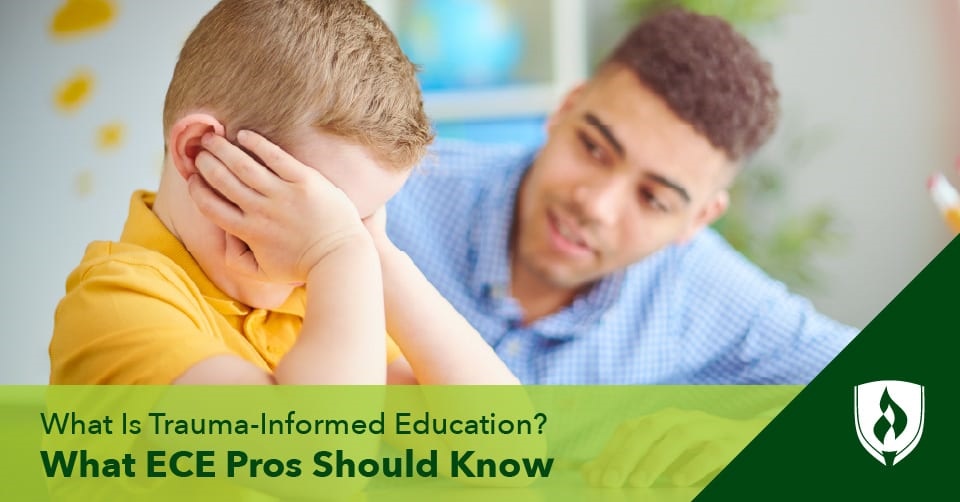
Do you remember a teacher who made a huge difference in your life? Maybe you were struggling in class or perhaps outside the classroom, and the teacher knew exactly what to say or do to help you feel supported and at ease.
There’s no doubt that early childhood education (ECE) professionals can make a huge difference in students’ lives. But how do the best educators spot when a student is going through a difficult time? And what can they do to help these students?
Applying a trauma-informed educational approach is one way that educators aid students through hard times and challenging life circumstances. In this article, we’re breaking down this impactful approach to education.
What is trauma-informed education?
Unfortunately, some children may experience trauma, which can affect their ability to learn, interact with peers and be successful at school. These children may exhibit behavioral issues or struggle with learning. As a result, educators need to be able to support these kids with an approach that helps them manage the trauma and, eventually, thrive in the classroom.
Simply put, trauma-informed education is when professional educators take into account any trauma their students may be experiencing. This approach seeks to recognize when children are facing trauma and adapt the classroom to help these kids.
How can educators identify trauma?
While trauma does not appear in all children in the same manner, there are several common ways that trauma manifests. An observant educator can spot these signs, recognizing that the child may be going through trauma rather than simply acting out.
A common key sign of trauma is poor social skills. Many signs of trauma will negatively impact a child’s social abilities. For instance, children experiencing trauma often have a hard time regulating their emotions. In practice, this means that the child who has outbursts of anger or unexpectedly turns to tears will struggle to get along with their peers.
Similarly, children experiencing trauma may also have difficulties reading other people’s emotions. Being able to understand what others are feeling is integral to social interactions, and children who cannot do this will struggle socializing.
As a result, these children will not make friends as easily and may find themselves isolated from their classmates. Furthermore, an astute teacher may observe changes or regression in the child’s language development and skills. In turn, this can affect the child’s ability to communicate and interact with their peers.
Another developmental impact of trauma involves stunting of the child’s imagination and creativity. This can manifest as a child struggling to play or take part in a creative and imaginative activity, further widening the divide between the child and their peers.
Finally, while some children will act out as a result of trauma, others will withdraw. It’s important for teachers to pay attention to all the children in their classroom—the kids who withdraw are easy to overlook, especially if they aren’t causing any trouble.
How can educators help children experiencing trauma?
While teachers don’t have the same toolkit or official qualifications as psychologists, they certainly can help kids navigate through trauma and make a huge difference in kids’ lives by providing a supportive and understanding environment. Indeed, as part of their job, they need to be prepared to still effectively teach through any barriers or difficulties that trauma causes for a child.
Talk with the child’s guardians
Each situation may be different, but reaching out to the child’s guardians is an important first step. Parents or guardians may know what the cause of the trauma is—perhaps a grandparent recently passed—and may be observing similar changes in the child at home.
For children, being able to talk to their parents is key to recovering from trauma. Talking with a trusted adult familiar with the situation helps them understand and come to terms with what happened.
The teacher can also be there for the child if the child wants to talk to them. When discussing trauma with kids, sympathetic listening is imperative, and educators should use simple, open-ended questions.
If the child’s home situation is troubled, then meeting the child’s caregivers may be able to clue the teacher in on what might be happening, whether it’s fighting at home or an ongoing divorce. While not every challenging home situation can be overcome, having some insight into the situation—and requisite empathy for the child—is a good starting point for educators to tailor their approach.
Working through trauma in the classroom
Identifying the source of the trauma gives teachers context to work with the child in the classroom. And depending on the caregivers, the teacher may be able to work with them to help the child move through the trauma both at home and at school with a consistent approach.
However, whether the source of the problem is known or not, there are several steps teachers can take to help children manage trauma—beyond simply recommending the child talk with a psychologist.
First, sympathy and attentiveness are paramount to successfully helping the child. Paying attention to the kid’s individual needs and situation as well as working with them is incredibly important. For instance, if the child’s trauma involved physical touch, then a comforting hug may actually upset them.
Indeed, there’s no one-size-fits-all solution for trauma-informed education. Some strategies may work better for some children or situations, and teachers should use discernment to identify what options are appropriate in each case.
For many children, consistency and stability allow them to feel safe and in control. Creating a daily schedule and posting it somewhere in the classroom helps kids know what to expect. And warning kids when the schedule is going to vary minimizes any panic resulting from facing something completely unexpected.
Furthermore, giving kids choices can also make them feel in control. Asking them whether they want indoor or outdoor recess or when they want snack time gives kids some autonomy, in contrast to traumatic events which often take away any control children have.
Techniques or activities that teach children to regulate themselves can help kids that struggle to manage their emotions learn better emotional discipline. For instance, a simple breathing exercise can be a useful tool that allows a child to practice controlling themselves.
Helping children beyond trauma
Early childhood professionals can have a huge impact on how children navigate trauma. The best educators are able to recognize the signs of trauma in children and implement classroom strategies to help the child cope and develop through the trauma.
Beyond trauma-informed education, teachers also help kids navigate the challenges that come with each stage of development. But despite these challenges, it’s a joy to watch kids grow and change as they hit developmental milestones. Learn more about these stages that all educators should understand with our article “Early Childhood Development Milestones: What You Should Know.” Additionally, check out our articles "Anti-Bullying Lesson Plans: 6 Ideas for Early Childhood Educators" and "Early Childhood Mental Health: 8 Things ECE Professionals Should Know".




